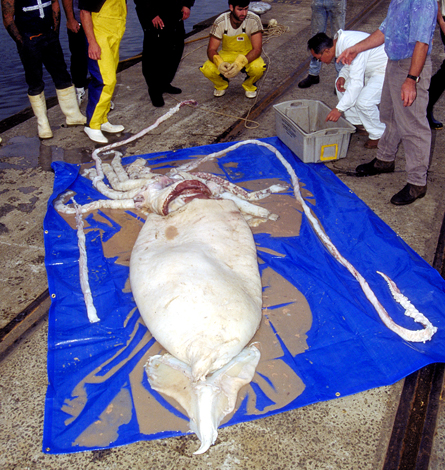- More than 2 years ago
Giant squid are so mysterious — and so huge — that they inspired the legend of the kraken, a Scandinavian sea monster. Now, a genetic analysis adds to the creatures’ mystique.

DNA evidence suggests that all giant squid are part of one global interbreeding species instead of the three that scientists previously thought existed, an international group of scientists reports March 20 in the Proceedings of the Royal Society B. The finding indicates the giant squid must migrate long distances to keep the breeding population well mixed.
The massive invertebrates also have some of the lowest genetic diversity of any species, the researchers report. That finding and the squid’s global interbreeding are nearly impossible for scientists to explain, says study coauthor M. Thomas Gilbert, a geneticist at the Natural History Museum of Denmark in Copenhagen. “We were very surprised by the results,” Gilbert says.
Most of what is known about giant squid comes from studying carcasses washed up on beaches, hauled in by fishermen or found in the bellies of sperm whales, the giant squid’s natural predator. Only last year did an expedition film a giant squid in its natural habitat. Researchers can describe the physical characteristics of the animals, which can grow to be about 18 meters long with parrotlike beaks, sucker-studded tentacles and eyes bigger than a person’s head. But not much is known about how the creatures live.
Gilbert and his team got a glimpse by examining mitochondrial DNA from 43 giant squid. Mitochondria are the energy factories inside cells. Scientists can trace a species’ life history through the DNA carried in mitochondria.
Researchers had thought there were three species of giant squid: one in the North Atlantic, a second in the southern oceans and a third smaller species in Japanese waters, says Clyde Roper, a marine biologist emeritus at the Smithsonian Institution’s Museum of Natural History in Washington, D.C. But the new analysis puts squid worldwide into what was thought to be the Atlantic Ocean-dwelling species, Architeuthis dux.
The genetic homogeneity suggests that somehow squid must travel long distances. A previous chemical analysis of the giant squid’s sharp beaks indicated that adults don’t migrate far. That means the juveniles and larvae must leave local waters and migrate around the world. Gilbert and his colleagues think “the young float around on the surface before they dive deep and become kingpins.” Surface currents could disperse the youngsters far and wide.
Roper calls the idea reasonable but notes that scientists have spotted only few young squid in the ocean’s upper reaches.
Generally, low diversity comes with small populations, but researchers think the giant squid population is huge, perhaps in the hundreds of millions. They only seem rare because they live in the deep sea, Roper says. “We don’t go where they go very often, and they don’t go where we go.”
Gilbert and his colleagues suggest that giant squid used to be rare but had a population explosion between 32,000 years and 730,000 years ago. The date spread is large because scientists don’t know how long giant squid take to reproduce or how frequently their DNA mutates.
Alternatively, the giant squid population might have been large in the past, but rapidly diminished — what scientists call a population bottleneck — and then grew again. “How can you bottleneck a species that lives globally?” Gilbert asks. “It’s a massive mystery.”
The researchers have found no trace of historical environmental conditions that might have caused a global bottleneck or rapid population expansion. Whaling may have dramatically reduced the number of sperm whales and enabled a giant squid boom. But whaling is far too recent to account for population growth starting 32,000 or more years ago. “It’s sort of a head-scratching thing,” Roper says of the population puzzle.
Gilbert says he hasn’t given up on the whaling hypothesis, but hopes that another solution may present itself. “What we’re really hoping is that somebody will read our paper and tell us, ‘You guys are crazy. This is the real answer.’”






